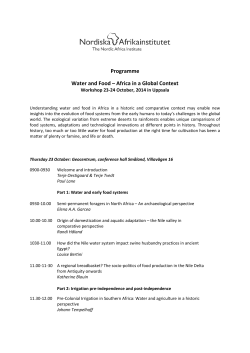
scheduling IRRIGATION MANAGEMENT SERIES 3:
scheduling SERIES 3: IRRIGATION MANAGEMENT Why schedule? Crops that are kept within acceptable stress limits during their growth cycle have the potential to produce optimum yields of high quality. The aim of irrigation scheduling is to keep soil moisture within a desired range, usually between field capacity (full point) and a predetermined refill point. Over-irrigating Scheduling involves deciding when and how much to irrigate by considering: Under-irrigating Benefits of scheduling How to schedule Further reading • your soil’s readily available water-holding (RAW) capacity • the application rate (millimetres per hour) of your irrigation system. This allows you to calculate how many hours are needed to apply the required amount of water (in millimetres). • the evenness of water application (DU%) and efficiency of the system • the current water content of the soil • the rate of crop water use. ➤ Why schedule? By failing to make an informed decision about when to irrigate and how much to apply, you risk either overirrigating or under-irrigating. ➤ Over-irrigating • can waterlog plants and damage crop health • wastes water that you have paid for • wastes pumping power • leaches nutrients • produces excess drainage • restricts property access. ➤ Under-irrigating • stresses plants, and reduces production • causes nutrient deficiencies • increases salt accumulation in the rootzone • can result in crop variation due to soil type and DU • can reduce production in the long term. ➤ Benefits of scheduling • healthy plants • efficient use of irrigation water • reduced drainage • potential to increase crop yields and quality. These benefits are more easily achieved when the irrigation system is applying water evenly. The benefits and success of scheduling are reduced if the distribution uniformity of the system (DU%) is below 75%. ➤ How to schedule To apply the right amount of water at the right time, you need some basic information about available soil moisture, system application rates and crop water use. ➤ Readily available water (RAW ) Readily available water (RAW) is the amount of water that a plant can easily extract from the soil for unrestricted growth. The RAW is calculated for the rootzone of the crop. With some scheduling systems (such as neutron probes and capacitance probes) you can refine the soil survey estimate of RAW. ➤ How much to apply Knowing the RAW and the application rate of your irrigation system allows you to calculate approximately how many hours of irrigation are needed. Once the soil RAW and system application rate are known, the right amount of water to apply has been determined. The next step is to determine the right time to irrigate. This requires measuring and estimating the rate of crop water use. Series 1 Irrigation farm resources ➤ Scheduling systems Several methods are available for estimating crop water use. These are all indirect measurements and require some assumptions. Each system has strengths and weaknesses and it is often recommended that more than one system is used. Series 2 Irrigation systems Series 3 Irrigation management There are three types of scheduling systems: 1. soil-based systems, monitoring soil moisture Author Jeremy Giddings, Irrigation Officer, Dareton Agricultural Research & Advisory Station 2. climate-based systems 3. plant-based systems, monitoring the plant. (Most of these are more suited to research situations than use by growers.) For more information contact WaterWise on the Farm Understanding the basis of each different scheduling system helps you to interpret the results. Phone 1800 255 444 ➤ Further reading Email waterwise@agric.nsw.gov.au NSW Agriculture, 2002, Irrigation for Horticulture in the Mallee, available from NSW Department of Primary Industries Bookshop on 02 6391 3994. Website www.agric.nsw.gov.au/waterwise © 2004 NSW Department of Primary Industries This publication is copyright. Except as permitted under the Copyright Act 1968, no part of the publication may be produced by any process, electronic or otherwise, without the specific written permission of the copyright owner. Neither may information be stored electronically in any form whatever without such permission Disclaimer The information contained in this publication is based on knowledge and understanding at the time of writing (July 2004). However, because of advances in knowledge, users are reminded of the need to ensure that information upon which they rely is up to date and to check currency of the information with the appropriate officer of NSW Department of Primary Industries or the user’s independent adviser. 5207 The product trade names in this publication are supplied on the understanding that no preference between equivalent products is intended and that the inclusion of a product does not imply endorsement by NSW Department of Primary Industries over any other equivalent product from another manufacturer.
© Copyright 2025





















